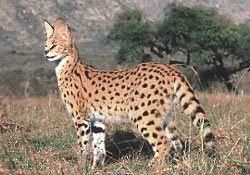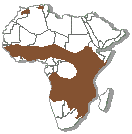|
|



Scientific Name: Leptailrus serval
Name Origin: Serval is Portuguese for "wolf-deer"
Size: Wild adult Servals weight 30-45 lbs. and stand about 22" tall at the
shoulders with males larger than females. They are 25 - 40" long, with a 12 - 18" tail.
Description: Servals are a medium-sized cat with golden coats containing
bold black rosettes. They have big ears with distinct white oceli (white
spots on the back of the ear) and long, slender legs.
Habitat: A Serval's habitat ranges from tall grasslands, savannahs, woods,
brushes, forests and marsh.
Range: Servals are found through the middle and southern parts of Africa.
They are almost always centered around water, which is why the range does
not include the driest areas of the continent including parts of the Sahara
desert.
Diet: The typical diet consists of rodents, insects and small birds caught
in mid-air.
Reproduction: The gestation period is around 63 days, after which 2-3 babies
are born. They will stay with their mother until around 10 months of age.
Life Span: Servals can live 20 years in captivity.
Status: 13 subspecies of the Serval are listed on CITES Appendix 2, with one
listed as endangered.
It is important to note, the Serval cat is classified as a "lesser cat", and should never be grouped with the bigger cats. Even though the Serval is sometimes called a miniature cheetah due to their similar appearance, they are in fact an entirely different species. The Serval coat is tawny in color with black stripes, spots and blotches, with a shorter tail banded with black. The Cheetah's ears are close to the head and rounded, whereas the Serval ears are much taller, pointed and have a disc-like movement.
The Serval's long and disc-like ears are used to detect the sound of movement. The cat has extraordinarily good hearing, and can pick up the ultrasonic high frequencies emitted by rodents and other small creatures.
They can easily hone in on prey with their tall ears. Once they pin point the position, from where the sound is emanating, they can easily spot their prey. Prey is stalked and then pounced upon in a leap. Their long legs
allows them to see just over the top of the grass, then leap straight up into the air to pounce on a rodent, mole rat, ground squirrel, or maybe a frog.
Rodents make up the bulk of the Serval's diet, but small and medium-sized birds are also regularly preyed upon. The Serval captures the birds in flight by leaping ten feet straight into the air and slapping them to the ground. Servals are not shy about entering water to hunt for ducks and other waterfowl. Frogs, reptiles and even fish are captured and eaten whenever the opportunity arises. The Serval is not known for attacking anything larger than a bird and will definitely not harm livestock. Even though they are sometimes blamed for sheep and poultry losses, jackals are more likely the culprits. Therefore, they are able to coexist with humans in the farmland areas of Africa.
While Servals pose no threat to humans, people are the main threat to Servals. They are hunted by people for their attractive coats and in some areas for their meat. Servals are losing their fight for survival in the wild, and have now dwindled down in numbers due to human over-population taking over their habitat and hunting them for their pelts. They are also preyed upon by the bigger cats and hyenas (Wild Dog). The big cats have been seen hunting and feeding on Servals. Spotted Hyenas are a major threat because they are often in direct competition with the Servals and will kill
them. There have been records of leopards and lions catching and feeding on Servals in various parts of the continent. Nile Crocodiles and African Rock Pythons pose a further threat to the adult Servals, while the young are most at risk to the Martial Eagle and other large birds of prey.
As far conservation goes, Servals breed easily in captivity. Some differences were discovered between the captive and wild Servals. It has been noted that captive bred (domesticated) Servals are much smaller in size and weight. TSCO will be conducting an extensive research project in the future to compare the different physical characteristics of the wild Serval in relation to the captive-bred domesticated Serval.
To find serval items, please visit our online store

|
